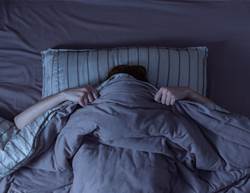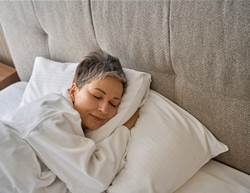Sleep apnoea is a serious disorder marked by interrupted breathing, frequent loud snoring, and gasping for air during sleep. Both the sufferer and his or her bed partner are likely to become stressed and exhausted from the noisy nightly drama. There are actually three types of this disorder:
- Obstructive sleep apnoea happens when the throat muscles relax enough to block air movement.
- Central sleep apnoea occurs when the brain doesn’t send proper signals to the muscles that control breathing.
- Complex sleep apnoea syndrome is a combination of the other two types.
Untreated, sleep apnoea can lead to daytime fatigue, high blood pressure, and Type 2 diabetes. Unfortunately, it can be difficult to diagnose because women and men tend to have different symptoms. Men usually display snoring and gasping, while women often report headaches, fatigue, depression, anxiety, insomnia, and sleep disruptions. It’s particularly important for women to undergo a monitored overnight sleep session at a specialised facility to be properly diagnosed.
Sleep apnoea treatment options
The most common is a continuous positive airway pressure (CPAP) machine. This pumps air through a strap-on mask to make inhalation easier. Other options include a mouthpiece to keep the jaw or tongue from obstructing air and physical therapy exercises to strengthen facial and tongue muscles. Severe cases may be treated surgically by removing the tonsils or moving the jaw forward to open the upper airway.
Newer treatments are also emerging. In one, hypoglossal nerve stimulation (HNS), a device is surgically implanted in the chest to monitor breathing and, when necessary, stimulate the nerve that keeps the airway open. Another new treatment, expiratory positive airway pressure (EPAP), uses adhesive valves to keep nostrils open during sleep.
Most of these solutions are uncomfortable or even painful (in the case of surgery) as well as expensive. The best natural treatment option for those who are overweight or obese is to shed some pounds. Obstructive sleep apnoea and obesity tend to occur together since excess fatty tissue narrows airways, making it easier for them to close up. According to the American Sleep Foundation, a weight loss of just 10% can make breathing interruptions less frequent.
How to overcome exhaustion
Until sleep apnoea is under control, staying awake and productive during the day can be hard. These can help:
- Green tea: It provides a modest dose of caffeine for alertness and the amino acid L-theanine for focus.
- Anti-inflammatory foods: A diet rich in fish, vegetables, fruits, and whole grains can moderate blood sugar and up energy.
- Ginseng: This herb may give you a boost without jitters, but ask your doctor before using it.
- Meditation: Guided imagery and other forms of meditation give you mental and physical verve.
- Reduce alcohol: Avoid drinking any alcohol after 6 p.m.
- Sleep on your side: If you tend to shift, get an adult side sleep positioner.
Ask your GP if sleep apnoea can be a side effect of any meds you take. If so, see if an adjustment can be made. If you take sleeping pills, talk to your doctor about weaning yourself off them.
For more articles by Prevention on sleep and wellbeing, sign up to our weekly newsletter.









